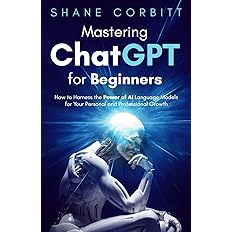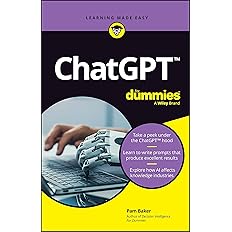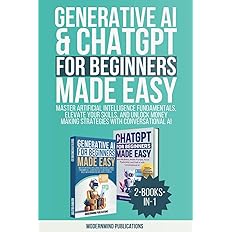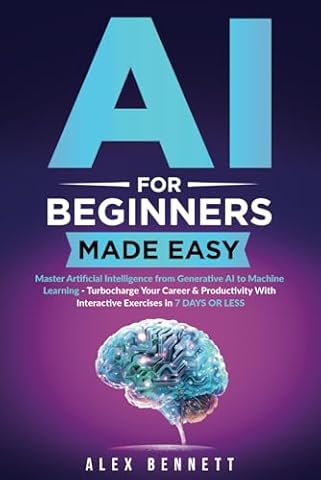Introduction
ChatGPT has transformed the educational landscape, offering unprecedented access to knowledge and personalized learning experiences. This AI-powered tool serves as a tireless tutor, ready to explain, challenge, and guide users through any subject.
It’s adaptability and instant feedback capabilities make it an invaluable resource for learners at all levels.
Articles similar to this one can be found at: https://aiismsforbeginners.com/

The AI Tutor in Your Pocket
ChatGPT’s large knowledge base and natural language processing abilities make it an exceptional learning companion. It can engage in discussions on virtually any topic, from basic concepts to advanced theories.
Adapting to Your Level
One of ChatGPT’s most impressive features is it’s ability to tailor explanations to the user’s level of understanding. For beginners, it breaks down complex ideas into simple, digestible chunks, often using analogies or real-world examples to clarify abstract concepts.
For advanced learners, it can engage in high-level discussions, exploring intricate theories and their implications.
This adaptability creates a truly personalized learning experience. ChatGPT adjusts its language, depth of explanation, and examples based on the user’s responses and questions, ensuring that the information is always presented at an suitable level.
Learn how to use the functions within ChatGPT here: https://amzn.to/4ayE7kc

Note: As an Amazon Associate, I may earn a commission from qualifying purchases.
Instant Feedback
Immediate feedback is crucial for effective learning, and ChatGPT excels in this area. Traditional education often involves long wait times for assessment, but ChatGPT provides instant responses and evaluations.
When writing an essay, users can receive immediate feedback on their argument structure, language use, and content accuracy. For math problems, ChatGPT can quickly identify errors in approach or calculation, allowing for rapid correction and reinforcement of correct understanding.
This rapid feedback loop speeds up the learning process, enabling users to identify and address misconceptions quickly. It also helps maintain motivation and engagement, as learners can see their progress in real-time.
Using begins with learning. Go here to learn more: https://amzn.to/4juYnYb

Note: As an Amazon Associate, I may earn a commission from qualifying purchases.
Beyond Information Dispensing
While ChatGPT is excellent at explaining concepts and answering questions, it’s potential extends far beyond being a simple information source. It serves as a versatile learning tool that can enhance various aspects of the educational journey.
Fostering Curiosity and Critical Thinking
ChatGPT has a unique ability to spark curiosity by presenting information from unexpected angles or asking thought-provoking questions. For example, during a discussion about the American Civil War, ChatGPT might introduce lesser-known facts about the role of women or the impact on Native American tribes.
This approach encourages a deeper, more nuanced understanding of historical events and often leads to further exploration.
ChatGPT also serves as an excellent tool for developing critical thinking skills. By presenting many perspectives on complex issues, it encourages learners to assess different viewpoints, question assumptions, and form well-reasoned opinions.
This multi-faceted approach to learning helps develop analytical skills that are valuable across all areas of study and life.
Enhancing Creativity
ChatGPT can be a powerful ally in fostering creative thinking. It serves as an effective brainstorming partner, helping generate ideas for writing projects, art concepts, or problem-solving scenarios.
For instance, when working on a short story, ChatGPT can suggest various plot twists, character backgrounds, or setting descriptions. This doesn’t replace human creativity but augments it, providing a springboard for imaginative leaps and helping overcome creative blocks.
Two books for those beginning to seek more information about ChatGPT: https://amzn.to/3CzRp3h

Note: As an Amazon Associate, I may earn a commission from qualifying purchases.
Implementing ChatGPT in Your Learning Routine
To maximize the benefits of ChatGPT as a learning tool, consider the following steps:
1. Define Your Learning Goals
Before engaging with ChatGPT, clearly outline what you want to learn. Are you aiming to master a new subject, improve specific skills, or explore a topic out of curiosity?
Having clear goals will help you use ChatGPT more effectively and stay focused on your learning goals.
2. Start with Broad Questions
Begin your interaction with ChatGPT by asking broad questions about your topic of interest. This approach helps you gain an overview of the subject and identify areas you’d like to explore further.
It also helps ChatGPT gauge your current level of understanding and adjust it’s responses accordingly.
3. Dive Deeper with Specific Queries
As you gain a better understanding of the topic, start asking more specific, detailed questions. Don’t hesitate to ask for clarification or examples if something isn’t clear.
This process of progressive inquiry helps build a comprehensive understanding of the subject matter.
4. Engage in Socratic Dialogue
Challenge ChatGPT’s responses by asking “why” and “how” questions. This back-and-forth dialogue deepens your understanding and helps develop critical thinking skills.
It also mimics the Socratic method of teaching, which has been proven effective in fostering deep learning and analytical skills.
5. Use ChatGPT for Application and Practice
Ask ChatGPT to generate practice problems or scenarios where you can apply what you’ve learned. This active engagement with the material significantly enhances retention and understanding. It also helps bridge the gap between theoretical knowledge and practical application.
6. Reflect and Summarize
After each learning session, use ChatGPT to help you summarize key points. This reflection process is crucial for consolidating your learning.
Ask ChatGPT to highlight the most important concepts covered and to explain how they connect to your broader learning goals.
AI made easy for you. Check it out here: https://amzn.to/3CfgsZB

Note: As an Amazon Associate, I may earn a commission from qualifying purchases.
Navigating Potential Pitfalls
While ChatGPT is a powerful learning tool, it’s important to be aware of it’s limitations and potential pitfalls:
Understanding vs. Familiarity
Reading an explanation can create a false sense of understanding. Always test your comprehension by trying to explain the concept in your own words or apply it to a new situation.
This active recall helps solidify your understanding and identifies areas that need further study.
Balancing AI Assistance and Independent Thinking
ChatGPT supports and enhances learning but doesn’t replace human thinking. The goal is to develop your own understanding and critical thinking skills.
Use ChatGPT as a tool to support your learning journey, not as a substitute for independent thought and analysis.
Fact-Checking is Essential
While ChatGPT has access to a large amount of information, it can sometimes make mistakes or present outdated information. Always cross-reference important facts with reliable sources, especially for critical or academic work.
Exploring Diverse Perspectives
ChatGPT bases it’s responses on your queries, which can potentially reinforce existing beliefs without challenging them. Make a conscious effort to explore different perspectives by asking for choice viewpoints or counterarguments to confirm a well-rounded understanding of the topic.
Adapting ChatGPT to Different Learning Styles
ChatGPT’s flexibility allows it to cater to various learning styles. Here are some strategies for different types of learners:
Visual Learners
Ask ChatGPT to describe concepts using spatial relationships or to suggest visual aids that might help explain complex ideas. For example, ask diagrams, charts, or metaphors that use visual imagery to illustrate abstract concepts.
Auditory Learners
Use text-to-speech software to listen to ChatGPT’s responses. You can also ask it to explain concepts using auditory analogies or mnemonics.
Request explanations that use rhythm, rhyme, or musical analogies to aid memory and understanding.
Kinesthetic Learners
Request hands-on experiments or real-world applications of concepts. Ask ChatGPT to guide you through step-by-step processes you can physically enact.
For example, when learning about chemistry, ask for kitchen experiments that demonstrate chemical reactions.
From Basics to Mastery: Building Your Knowledge
ChatGPT supports learners at all levels, from beginners to experts. Here’s how to use it effectively as you progress in your learning journey:
Establishing a Strong Foundation
Start by ensuring you have a solid grasp of the basics. Use ChatGPT to fill in any gaps in your understanding.
Ask for simplified explanations of basic concepts and ask examples that illustrate these principles in action.
Gradual Complexity Increase
As you become more comfortable with the basics, gradually increase the complexity of your queries. Ask about advanced concepts, explore interconnections between different ideas, and look at current research and debates in the field.
Applying Knowledge in Novel Contexts
True mastery involves not just knowing facts, but understanding the broader context and being able to apply knowledge in novel situations. Use ChatGPT to generate hypothetical scenarios or complex problems that require you to apply your knowledge in new ways.
Engaging with Current Research
As you approach expert level, use ChatGPT to stay updated on current research and debates in your field. Ask about recent discoveries, ongoing controversies, or emerging theories.
This keeps your knowledge current and helps you engage with the cutting edge of your field.
Contributing New Ideas
At the highest levels of mastery, you may find yourself able to contribute new ideas to your field. Use ChatGPT as a sounding board for your theories or hypotheses.
While it can’t confirm new research, it can help you refine your ideas by asking probing questions or suggesting potential flaws in your reasoning.
Here is a definitive guide on ChatGPT: https://amzn.to/4gobU12

Note: As an Amazon Associate, I may earn a commission from qualifying purchases.
Practical Exercises to Enhance Your Learning with ChatGPT
To maximize the benefits of ChatGPT as a learning tool, try these exercises:
Concept Mapping
Ask ChatGPT to help you create a concept map for a topic you’re studying. Start with a central concept and ask ChatGPT to suggest related ideas, then explore how these ideas connect.
This visual representation helps you understand the relationships between different aspects of a topic.
For example, if you’re studying ecology, you might start with “ecosystem” as your central concept. Ask ChatGPT to suggest related concepts like “food web,” “biodiversity,” “abiotic factors,” etc. Then explore how these concepts interact and influence each other.
Debate Preparation
Use ChatGPT to explore different sides of a controversial topic. This exercise helps you develop a more nuanced understanding and improves your argumentation skills.
Start by asking ChatGPT to outline the main arguments for one side of a debate. Then, ask for the counterarguments.
Finally, use this information to formulate your own position, considering the strengths and weaknesses of each perspective.
Problem-Solving Practice
Ask ChatGPT to generate problem scenarios related to your field of study. Try to solve them, then talk about your approach with ChatGPT.
This exercise helps you apply theoretical knowledge to practical situations and improves your problem-solving skills.
For instance, if you’re studying business, you might ask ChatGPT to create a scenario involving a company facing a specific challenge. Develop a solution, then ask ChatGPT to assess your approach and suggest alternatives.
Language Learning Conversations
For language learners, engage in conversations with ChatGPT in your target language. It can help with vocabulary, grammar, and cultural context.
Start with simple exchanges and gradually increase complexity as your skills improve.
Ask ChatGPT to role-play various scenarios, such as ordering in a restaurant or having a job interview. This practice helps you prepare for real-world language use in a low-pressure environment.
Historical Perspective Taking
Ask ChatGPT to help you view historical events from different perspectives. This enhances your understanding of history and develops empathy.
For example, when studying a particular historical event, ask ChatGPT to describe how different groups or people might have experienced or perceived it.
You might explore how a peasant, a noble, and a clergy member each viewed the French Revolution. This multi-perspective approach deepens your understanding of historical complexities.
Leveraging ChatGPT for Research and Academic Writing
ChatGPT can be a valuable tool for academic research and writing, helping you streamline your process and enhance the quality of your work.
Literature Review Assistance
When starting a research project, use ChatGPT to help you identify key papers and researchers in your field. Ask for summaries of influential works or explanations of important theories.
This can help you quickly get an overview of your research area and identify gaps in the literature.
Remember, while ChatGPT can provide a starting point, always verify information with primary sources and conduct your own thorough literature review.
Structuring Your Arguments
ChatGPT can help you organize your thoughts and structure your arguments effectively. Describe your main thesis to ChatGPT and ask for suggestions on how to structure your paper.
It can help you identify key points to cover and suggest a logical flow for your arguments.
Improving Your Writing Style
Use ChatGPT to help refine your academic writing style. You can ask it to rephrase sentences for clarity, suggest more formal choices to casual language, or help you vary your sentence structure for better flow.
Generating Ideas for Future Research
After completing a project, use ChatGPT to brainstorm ideas for future research. Describe your findings and ask ChatGPT to suggest potential follow-up studies or unexplored angles related to your topic.
Ethical Considerations in Using ChatGPT for Learning
While ChatGPT is a powerful learning tool, it’s important to use it ethically and responsibly.
Avoiding Plagiarism
Never present ChatGPT’s responses as your own work. Use it for inspiration, clarification, and to guide your learning, but always write your own original content for assignments and papers.
Maintaining Academic Integrity
Be transparent about your use of AI tools in your learning process. If you’re unsure about the acceptability of using ChatGPT for a particular task or assignment, talk to your instructor or academic advisor.
Developing Independent Thinking Skills
While ChatGPT can provide valuable information and insights, it’s crucial to develop your own critical thinking and problem-solving skills. Use ChatGPT as a tool to support your learning, not as a replacement for independent thought.
Recognizing AI Limitations
Remember that ChatGPT, while highly capable, is not infallible. It can make mistakes or provide outdated information.
Always verify important information with reliable sources and use your own judgment.
Integrating ChatGPT with Other Learning Tools
To maximize your learning potential, consider integrating ChatGPT with other educational tools and resources.
Complementing Traditional Textbooks
Use ChatGPT alongside your textbooks to get choice explanations or examples. If you’re struggling to understand a concept from your textbook, ask ChatGPT for a different perspective or a more detailed breakdown.
Enhancing Online Courses
When taking online courses, use ChatGPT to supplement your learning. Ask it to explain concepts you find challenging or to provide extra examples beyond what’s covered in the course material.
Supporting Group Study Sessions
In group study settings, use ChatGPT to generate discussion questions or to provide explanations when your study group is stuck on a particular topic. This can help keep your study sessions productive and engaging.
Aiding in Project-Based Learning
For project-based learning, use ChatGPT to help brainstorm ideas, plan project steps, or troubleshoot issues you encounter along the way. It can serve as a valuable resource throughout your project journey.
The Future of AI in Education
As AI technology continues to advance, tools like ChatGPT are likely to play an increasingly significant role in education.
Personalized Learning Paths
Future iterations of AI tutors may be able to create fully personalized learning paths, adapting not just explanations but entire curricula based on person learning styles, pace, and goals.
Enhanced Interactivity
We may see more interactive features, such as AI-generated visualizations or simulations that respond in real-time to user input, providing an even more immersive learning experience.
Integration with Virtual and Augmented Reality
AI tutors like ChatGPT could be integrated with VR and AR technologies, creating immersive learning environments where students can interact with AI-guided historical figures or conduct virtual science experiments.
Collaborative AI Learning
Future developments might enable many users to interact with an AI tutor simultaneously, fostering collaborative learning experiences and group problem-solving skills.
Frequently Asked Questions
How does ChatGPT compare to human tutors?
ChatGPT offers 24/7 availability and a large knowledge base, but lacks the emotional intelligence and adaptability of human tutors. It’s best used as a complement to, not a replacement for, human instruction.
Can ChatGPT help with language learning?
Yes, ChatGPT can assist with vocabulary, grammar, and conversation practice in many languages. However, it’s important to supplement this with real-world language use and native speaker interaction.
Is ChatGPT suitable for all age groups?
While ChatGPT can be useful for learners of all ages, it’s effectiveness may vary. Younger learners might need guidance to use it effectively, while adult learners can often engage with it more independently.
How accurate is the information provided by ChatGPT?
ChatGPT’s information is generally reliable, but not infallible. It’s always important to verify critical information with authoritative sources, especially for academic or professional use.
Can ChatGPT help with test preparation?
ChatGPT can be a valuable tool for test prep, offering practice questions, explanations, and study strategies. However, it’s important to use official study materials as well, especially for standardized tests.
How can educators incorporate ChatGPT into their teaching?
Educators can use ChatGPT to generate discussion questions, create personalized homework assignments, or provide extra explanations for complex topics. It can also help in lesson planning and creating educational materials.
Does using ChatGPT for learning have any drawbacks?
Potential drawbacks include over-reliance on AI, the risk of encountering inaccurate information, and the possibility of using it as a shortcut as opposed to developing independent thinking skills. It’s important to use ChatGPT as a supplement to, not a replacement for, traditional learning methods.
How can I confirm I’m using ChatGPT effectively for learning?
To use ChatGPT effectively, set clear learning goals, engage actively by asking follow-up questions, apply what you learn to real-world scenarios, and always verify important information with reliable sources.
Can ChatGPT help with subjects like math and science?
Yes, ChatGPT can explain mathematical and scientific concepts, help with problem-solving, and even guide you through complex calculations. However, for advanced topics, it’s important to verify it’s explanations with textbooks or expert sources.
How does ChatGPT handle different learning styles?
ChatGPT can adapt to different learning styles by providing varied explanations, examples, and analogies. You can ask information be presented in ways that suit your preferred learning style, whether that’s visual, auditory, or kinesthetic.
Key Takeaways
- ChatGPT serves as a versatile AI tutor, adapting to different learning levels and providing instant feedback.
- It fosters curiosity, critical thinking, and creativity by presenting information from many angles and encouraging active engagement.
- Effective use of ChatGPT involves setting clear goals, engaging in Socratic dialogue, and actively applying learned concepts.
- While powerful, ChatGPT has limitations.
Users should be aware of potential pitfalls like over-reliance and the need for fact-checking.
- ChatGPT can be adapted to various learning styles and used to progress from basic understanding to mastery of complex subjects.
A great cost-saving tool you need can be found at: https://galaxy.ai/?ref=gary
This post contains links. If you click on these links and make a purchase, I may earn a commission at no additional cost to you. Rest assured, I only recommend products or services I believe will add value to my readers. As an Amazon Associate, I may earn a commission from qualifying purchases.
Articles similar to this one can be found at: https://aiismsforbeginners.com/
